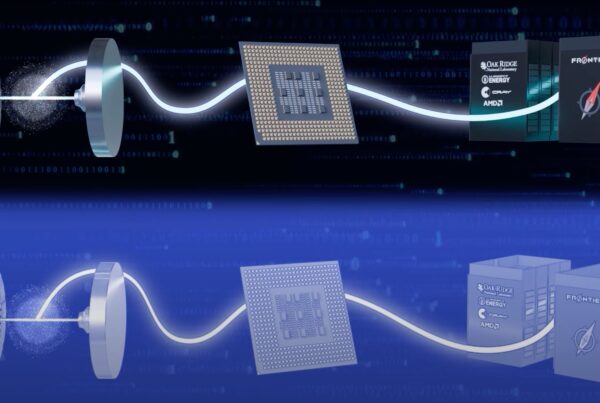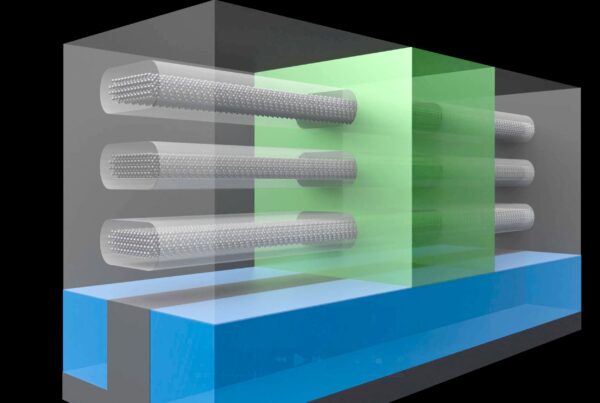Researchers used the world’s fastest supercomputer for open science to uncover new insights that could pave the way for the next generation of quantum computing, sensing and communications technologies through more efficient control of quantum materials and their properties.
The study conducted on the Frontier supercomputer at the Department of Energy’s Oak Ridge National Laboratory used a first-principles code, BerkeleyGW, to simulate the coupling of correlated electrons and phonons and their effects on quantum materials as part of the quantum many-body problem, one of the most challenging problems of quantum physics.
The work earned the team a finalist nomination for the Association for Computing Machinery’s Gordon Bell Prize, which honors innovations in applying high-performance computing for scientific discovery. This year’s prize will be presented at the International Conference for High Performance Computing, Networking, Storage, and Analysis, which takes place Nov. 16-21 in St. Louis, Missouri.
The team will discuss their study on Tuesday, Nov. 18, at the conference.

Researchers used ORNL’s Frontier to model coupling between electrons and phonons in settings including this system of iithium hydride atoms. Results could pave the way for the next generation of quantum computing, sensing and communications technologies through more efficient control of quantum materials and their properties.
Credit: Chih-En Hsu, Tamkang University
“This work marks the culmination of more than 10 years of research,” said Mauro Del Ben, a computational research scientist at Lawrence Berkeley National Laboratory and senior author of the study. “The new capability to describe these properties in so much detail offers hope we can design new technologies to take advantage of these phenomena for energy production, quantum communication and much more. We couldn’t have done this without Frontier.”
The coupling between electrons, the negatively charged particles present in all atoms, and phonons, or waves of vibrational energy, drives key physical processes such as superconductivity, or the ability to conduct electricity with minimal to no resistance, and photovoltaics, the generation of energy from light. Deeper understanding of that coupling and how it occurs could help scientists reproduce and harness those processes for batteries, generators, transistors and more.
But modeling those interactions in full detail would require a computer that can model each particle’s interaction with every other particle through an exponentially increasing series of equations. A problem of that scale exceeds the capabilities of even the most powerful classical supercomputers.
The BerkeleyGW simulations on Frontier, the flagship supercomputer at ORNL’s Oak Ridge Leadership Computing Facility, came the closest yet.
“We’re talking about a very messy problem because there are so many interactions between the electrons, the phonons and the rest of their environment as the atoms vibrate,” said Zhenglu Li, a co-author of the study and assistant professor of chemical engineering and materials science at the University of Southern California. “Even for a problem with just 10 atoms, the calculations increase so quickly that we can scale up only an order or so of magnitude before we hit a wall. But a machine with Frontier’s power gives us factors of speedup that finally make these calculations possible.”
Frontier’s exascale speeds of more than 1.4 quintillion calculations per second enabled the team to model coupling between electrons and phonons within a system of up to 2,742 silicon atoms and a system of up to 17,574 atoms of lithium hydride.
The team’s computational framework, BerkeleyGW, relied on many-body perturbation theory, a quantum theoretical approach that enables highly accurate predictions of the electronic structure of complex materials. The methods developed within BerkeleyGW open new possibilities for quantum technologies; materials design; and the study of electron-phonon coupling phenomena that underlie superconductivity, nanoelectronics and photovoltaics.
“By extending these capabilities to capture time dynamics out of equilibrium, we can explore ultrafast processes such as chemical reactions, photosynthetic energy transfer, and other key mechanisms driving next-generation quantum and energy materials,” Del Ben said.
The simulations ultimately reached speeds of more than an exaflop, or a quintillion calculations per second — some of the fastest performed on the machine — modeling more than half a million interactions at double precision, a computationally intensive standard that relies on 64-bit arithmetic for high accuracy.
A similar run on Argonne National Laboratory’s Aurora supercomputer reached speeds of 707.5 petaflops, or 707.5 quadrillion calculations per second.
“This is why we need computers like Frontier,” said Benran Zhang, a co-author of the study and USC graduate student. “We’re exceeding the limits of typical approaches, but we’d pay a huge computational cost on any other machine to the point these simulations couldn’t even be done.”
Next steps include tweaking the code to make it more portable across platforms.
“As we learn more about how these particles interact to produce these properties, we move closer to applying these insights,” Del Ben said.
Besides Del Ben, Li and Zhang, the research team included James B. White III of ORNL; Daniel Weinberg, Steven G. Louie and Jack Deslippe of LBNL; Aaron R. Altman and Yuming Shi of Stanford University; Derek Vigil-Fowler of the National Renewable Energy Laboratory; Felipe H. da Jornada of SLAC National Accelerator Laboratory; and Chih-En Hsu of Tamkang University in Taiwan.
This research was supported by the DOE Office of Science’s Advanced Scientific Computing Research program and LBNL’s Center for Computational Study of Excited-State Phenomena in Energy Materials. The OLCF is a DOE Office of Science user facility at ORNL.
UT-Battelle manages ORNL for DOE’s Office of Science, the single largest supporter of basic research in the physical sciences in the United States. DOE’s Office of Science is working to address some of the most pressing challenges of our time. For more information, visit https://energy.gov/science.






